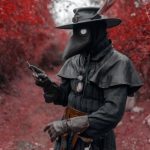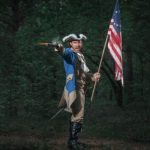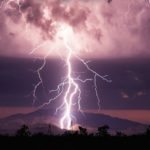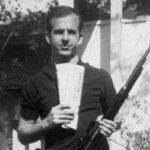 Mysteries
Mysteries  Mysteries
Mysteries  History
History 10 Surprising Stories About the Texas Rangers
 Humans
Humans 10 Philosophers Who Were Driven Mad by Their Own Theories
 Miscellaneous
Miscellaneous 10 Video-Game-Worthy Weapons and Armors from History
 Weird Stuff
Weird Stuff 10 Psychics Who Accurately Predicted Wartime Events
 The Arts
The Arts 10 Pieces of Art Inspired by a Broken Heart
 Health
Health 10 Science Fiction-Sounding New Medical Treatments
 History
History 10 Surprising Facts About the Father of Submarine Warfare
 Space
Space Ten Astonishing New Insights into Alien Worlds
 Weird Stuff
Weird Stuff 10 Bizarre Summer Solstice Rituals Still Practiced Today
 Mysteries
Mysteries Top 10 Haunting Facts About the Ghost Ship MV Alta
 History
History 10 Surprising Stories About the Texas Rangers
 Humans
Humans 10 Philosophers Who Were Driven Mad by Their Own Theories
Who's Behind Listverse?

Jamie Frater
Head Editor
Jamie founded Listverse due to an insatiable desire to share fascinating, obscure, and bizarre facts. He has been a guest speaker on numerous national radio and television stations and is a five time published author.
More About Us Miscellaneous
Miscellaneous 10 Video-Game-Worthy Weapons and Armors from History
 Weird Stuff
Weird Stuff 10 Psychics Who Accurately Predicted Wartime Events
 The Arts
The Arts 10 Pieces of Art Inspired by a Broken Heart
 Health
Health 10 Science Fiction-Sounding New Medical Treatments
 History
History 10 Surprising Facts About the Father of Submarine Warfare
 Space
Space Ten Astonishing New Insights into Alien Worlds
 Weird Stuff
Weird Stuff 10 Bizarre Summer Solstice Rituals Still Practiced Today
Ten Things You Know about Cowboys That Are Totally Wrong
They’re the folks with that tough, aloof, and even distant look in their eyes. They are armed with six-shooters, always rocking wide-brimmed hats, and have enough grit to chew through the toughest steak. Of course, we’re talking about cowboys, renowned worldwide for their coolness, composure, and heroic tales. And their amazing stories are etched into the fabric of American legend and lore.
But what if we told you that the image of cowboys you were taught about growing up isn’t entirely accurate? What if we unveiled a real version of cowboys with fewer stoic standoffs and more peculiarities like camels, questionable hygiene, and awful diseases? In this list today, you’ll learn ten astonishing and unexpected facts about the true pioneers of America’s untamed western frontier. These aren’t the cowboys you learned about in school—they’re the real thing. Yee haw!
Related: Top 10 Grisly Tales From The American Frontier
10 A Horse of a Different World
When you think of a cowboy, what do you think of? The hat, the belt buckle, the boots, the spurs, and… the horse. Well, we have bad news: It might be time to drop the horse. Many cowboys rode horses at some point in their careers, but many, many more did not. In fact, after the winter of 1885, things markedly changed in the West to the detriment of those free-riding cowboys.
The weather that winter was devastating. Countless heads of livestock were lost in blizzards and other brutally inclement weather patterns. Ranch heads and landowners took massive losses on their properties, and it changed the way they did business forever after. Mostly gone were the days of long cattle drives into faraway open pastures. Livestock was kept far closer to home than had ever been the case before.
Ranch owners simply couldn’t stomach the thought of going through such a financially back-breaking winter ever again. Plus, it didn’t help that more of the West was being settled with each passing year. Urban areas were expanding, and as the West continued to be “won,” the need for the rough-and-tumble ways of the past diminished more and more. Through it all, cowboys went from riding hard in cattle drives to staying close to home and (literally) mending fences.
That’s not to say all cowboys hopped off their mounts. There are still plenty of amazing stories from the frontier about these hard workers bonding with incredible horses. Still, many horses they rode in the old days weren’t their property. The animals were owned by the ranch owners who employed the cowboys and loaned the horses to the men after they got the gig. Consider it something like a company car perk—but in the 19th century.[1]
9 Cowboys Had Camel Culture
Get it? Camel culture? Sort of like cancel culture, but with a hump? Ah, forget it.
Old-school cowboys may not have ridden horses as frequently or as long as is popularly depicted. But they did ride other things: camels! In several parts of the American Southwest, camels were a thing. The U.S. government introduced hundreds of camels to camps in Arizona to test whether the big beasts could withstand our deserts as they did in the Sahara. Other private importers brought camels en masse to areas of California and Nevada, where similarly dry climates had them feeling right at home.
However, the government never quite got what they wanted from their camel experiment before the Civil War. And when that conflict really kicked up, a crazy thing happened: A rag-tag band of Confederate soldiers raided a camp that had been holding the camels and released all the animals into the desert wilds.
For years after, landowners across Arizona and California would pick up stray camels and put them to use on farms and ranches. For any of their cowboys who didn’t have horses on hand, riding a camel was a good enough substitution.[2]
8 Vicious, Vicious VD…
Well, this is a bit of an awkward thing to go over, but we’re all adults here, right? Cowboy life was not exactly a clean-cut profession. The men who worked these jobs were absolutely filthy nearly all the time. They rarely bathed—especially by today’s standards—and when they did, that mostly meant jumping in a pond or lake or taking an impromptu bath in a stream. The grime isn’t really the problem here, though. We can look past that, especially considering these guys were putting in an honest day’s labor. The real issue is what was going on inside—and, uh, you know, below… in their private areas.
Okay, we’ll just say it: Many cowboys on the American frontier tended to be carriers of more than a few sexually transmitted diseases. Depending on the actual city and the time period, historians believe at least half and possibly closer to ninety percent (!) of prostitutes in Old West towns had venereal diseases. They very often got those from the cowboy and other men they came into contact with in brothels and saloons. Then, they passed these STDs on to still more cowboys looking for a night of relaxation after a hard week of work.
It was a vicious cycle, and it was made worse by the fact that Americans of that time didn’t have anywhere close to our medical know-how. So there weren’t many options for successfully treating and eradicating these annoying and often deadly disorders. True STD rates are hard to come by, of course. But historians know the spread was significant, and it lasted a very long time. Suffice it to say, it probably hurt quite a few cowboys when they had to pee…[3]
7 Trysts on te Range
When Brokeback Mountain hit theaters in 2005, moviegoers were shocked to see the story of a cowboy’s sexual affair unfold on the big screen. It was a made-up tale meant for the movies, of course. But the truth is that there was more than a bit of homosexual behavior among cowboys than you might have expected.
Historians contend that the very nature of the job—being away from people for long periods of time—necessitated these men do certain things to have their needs met. That means pushing through long, lonely conditions in close quarters with what was usually the only other person around: another cowboy.
It’s not just expert opinion, either. Historians have uncovered actual love poems written between cowboys. Men on the frontier were unencumbered by many of society’s hangups. They weren’t really a part of society in some ways, instead living on their homesteads and free from the social customs that dominated those living in the East. So the ones who were interested in swinging that way, as it were, didn’t show much fear in showing their love for their equally lonely peers.
When it got lonely out on the range without women, like-minded men could help relieve each other’s sexual tension. Plus, other cowboys were closeted gay men who’d chosen to leave stuffy society back east. The anonymity of the range worked well for them. They could reinvent themselves out west. Soon enough, many found others who were doing the same thing. It wasn’t every cowboy, of course, but it was certainly common enough to be a thing in frontier circles until the West was won.[4]
6 A Gun-Free Gig
It’s very common to think of a cowboy as someone who carried a gun and had to use it often. Whether a pistol or a rifle, the image of an armed cowboy is burned into the brains of many Americans. It’s not too different from that of an armed Old West outlaw. There’s just one problem: It isn’t true.
Forget about Clint Eastwood, John Wayne, and all the rest. Real-life cowboys from the 19th and very early 20th centuries weren’t armed for a fight. They weren’t gunslingers ready to fire at a moment’s notice; they didn’t use the weapons to just use their weapons! Cowboy job duties involved building and mending fences, driving cattle into pastures, and tending to livestock. None of that required weapons, really. Unless they had to fend off a wolf or a thief.
There was another part of the story, too: In old Wild West towns, guns were very often outlawed. Sure, Billy the Kid and other true gunslingers couldn’t be bothered to follow those laws, so guys like that went armed pretty much everywhere they turned up. But real, true cowboys—non-criminal pioneers who did honest work on ranches and the like—couldn’t afford to get on the local sheriff’s bad side.
So, as gunfights swept across the Old West, countless county sheriffs did what they had to do and enacted gun control. Anyone who rode into town had to disarm themselves. Even the notorious Wild West outpost Tombstone, Arizona, banned firearms. The criminal element didn’t tend to heed those warnings, of course. But the regular ol’ cowboys sure did![5]
5 Instagram Influencers of the Old West?
They didn’t have Instagram in the Old West, but their version of self-promotion was nearly as surprising—and twice as toxic. Outlaws and outspoken cowboys would ride around towns in the Wild West, bragging about their exploits. While we’ve learned by this point that most cowboys were not outlaws, the era’s outlaws nevertheless played into the cowboy theme. And then used that style and reputation to promote themselves. They were unashamed and completely unembarrassed, and everything they did was big and bawdy.
Take Jesse James, for example. Whenever he held up a train, he passed a piece of paper to at least one witness on board. That note boasted about James’s exploits, explained why he was doing what he was, and inflated many of his past robberies and daring escapes. Billy the Kid engaged in this mythmaking, too, deliberately tripling his kill count and spreading it to whoever would listen (and many who wouldn’t). The truth was he was mostly rustling cattle. It wasn’t quite as sexy as murder, but it got the law on his case all the same.
As for the real cowboys out west, most of them were decidedly less into the self-promotion game. But that was actually sort of the problem. Cowboys were isolated from the world—even from frontier towns, for the most part—and low-rent outlaws glommed onto their reputations as tough and capable pioneers for their own selfish glory.
Cowboys were too busy and too far away to make much of a stink. So sleazy outlaws stole their so-called valor. It wasn’t cool, but the gunslingers’ move to take credit for cowboy culture is a significant part of why the lore entered mainstream culture in the first place.[6]
4 Support from WHERE?
If you thought Americans loved cowboys (and Indians), you ain’t seen nothing. Our friends across the pond (and then some) over in Germany have taken a significant liking to all things Old West. It’s unclear why, exactly, but for a century now, Germans have followed the exploits of America’s gunslingers, pioneers, and frontier homesteaders.
In modern Germany, there are hundreds of private clubs where locals can go dress up as cowboys and make believe like they’re living in old frontier times. These contemporary German clubbers enjoy a fantasy camp of sorts, all based on what life was like back in the 19th-century American Southwest. Some estimates claim thousands of people pop up at these sites in the European nation every weekend!
It’s not just modern Germans who are fascinated by cowboy culture, though. Back in the 1930s, cowboy culture became an obsession for none other than Adolf Hitler. The infamous Nazi party leader loved the idea of cowboys riding rough and rugged across the range. He felt they were the embodiment of true masculinity.
A lot of people did (and still do), so it’s at least understandable where that thought came from. Plus, Hitler was a huge fan of westerns and was known to read cowboy books during his spare time while he wasn’t out committing genocide and destroying Europe. Everybody’s got a hobby or two, we suppose…[7]
3 They Couldn’t Get No Respect
In modern American culture, cowboys are respected and loved. We’ve already been through the entertainment history and pop culture references that have come from the era. John Wayne, Clint Eastwood, and the rest of ’em didn’t appear out of thin air, after all. But the sad and interesting fact is that back in the day, when real cowboys were really roaming the plains, they weren’t seen as anything special. And in some social circles, they were actually viewed as far less than that!
In the frontier’s earliest days, cowboys were widely regarded as poorly educated drunks, scofflaws, and vagrants. Ranchers and homesteaders generally felt they weren’t reliable and couldn’t be trusted. Many landowners and claim stakers did their best not to hire cowboy labor because of the poor perception.
It wasn’t just the cowboys themselves who drew the wrath of other Americans. The duties they had to do out on the range hurt them, too. East of the Mississippi, early 19th-century cowboys were notorious for driving cattle through farmers’ fields. They destroyed the crops of others, all for the pursuit of profit for their own bosses. And early on in the West, they pulled those same stunts with Native Americans’ land. Considering how obviously important these crops were to farmers on both sides of the mighty Mississippi, it didn’t take long for cowboys’ bad reputation to spread.
For a while, the terrible take stuck among homesteaders. Cowboys were mean, rude, smelly, disease-ridden, stupid, and vengeful. Most people didn’t want much to do with them. Then, the calendar turned to the 20th century. As the West was fully won, writers of the era began to grow nostalgic about life before their version of modernity. So, pulp novelists and early Hollywood filmmakers alike brought the newly-imagined cowboy to the public. They were no longer smelly, foul men. Now, they were rugged and stoic heroes who conquered America for the rest of us. The carefully crafted image stuck, and now, this is how the entire world seems to know cowboys.[8]
2 Don’t Fight, Friends!
The Old West was considerably less violent than you think. Yes, it’s been drilled into all our heads that there were constant bank robberies, endless shootouts, and plenty of high-speed train heists to boot. But the truth is actually far more tame than some of the old spaghetti westerns and serialized pioneer periodicals would have you believe.
Take this shocking statistic: In 2005, the University of Dayton did a study on bank robberies. They found that there had been more bank robberies in one year in the modern-day Ohio city than there were across an entire decade in the Old West! There’s no question the frontier had plenty of awful and violent behavior. But fights, shootouts, robberies, heists, and hold-ups were far less common than you have been led to believe.
Here’s where that links back to cowboys: Working alone or in small groups on ranches and in rural areas required them to get along well with their neighbors. Life was very, very hard out in the Wild West. Diseases took hold in a flash and illness and injury crept up with little warning. Even simple things we take for granted, like grabbing a bite to eat, were never certain back then.
So the John Wayne-imagined ideal of a man relying only on himself wasn’t how reality worked back in the day. Cowboys may not have interacted much with neighbors at various points while working alone or in pairs on ranches. But you can bet they needed to maintain good connections with neighbors and other townsfolk for when those challenging moments did come up. It was far easier than actually going it alone.[9]
1 They Weren’t All White
There aren’t a ton of black cowboys in popular culture. Sure, Django Unchained comes to mind, as does Blazing Saddles. But except for those precious few exceptions, cowboy culture is shown as mostly white culture. But the truth is far more complicated than that. Some historians believe as many as a quarter of cowboys in the 19th century were Black. Possibly as much as another quarter were Hispanic, too, though numbers are harder to come by in the Southwest with those groups. Still, there were plenty of non-white cowboys, including Native Americans.
Some of it came down to sheer numbers. Out in rural areas and far-flung places on the frontier, landowners and ranch heads needed all the help they could get. They weren’t exactly rolling in potential manual labor hires. So when a strong man showed up—no matter their race—it was tough to turn them away. Plus, you have to remember the time period we’re talking about here.
While westward expansion was obviously happening before the Civil War, it really blew up in the three decades after the Confederacy lost. It took a long time for racial attitudes to change back east, of course. But out west, ranchers and farmers were more than ready to move on and get back to work.
Despite all this, Black cowboys didn’t exactly have it easy out west. There was still a ton of racism, discrimination, and disrespect. The realities of life in America at that time didn’t magically disappear out on the frontier. And in some ways, cowboy duties were actually even more difficult for those who weren’t white.
Black cowboys routinely got stuck with the hardest jobs. They were forced to break in wild horses, do all the cooking on cattle drives, and brand cattle endlessly on the homefront. Still, they had more autonomy and drew more respect than many Black citizens back east. So maybe it’s no wonder why so many former slaves pushed west after the Civil War ended.[10]








